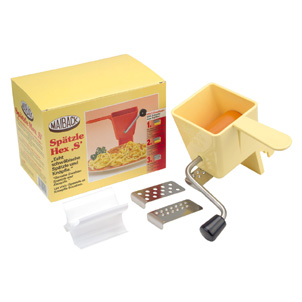Bryanna Clark Grogan’s Vegan Feast Kitchen/ 21st Century Table: The kitchen journal of a vegan food writer.. I'm on Facebook and Twitter (see links in sidebar at right).
Thursday, March 26, 2009
FARRO MINESTRONE WITH WINTER SQUASH AND GREENS

Farro Minestrone with Squash and Greens
We're heading for Vancouver tomorrow, for a much-needed little holiday (4 days only). We'll stay with my cousin Chris and his partner Roxanne, and spend time with my sister, Karin, my youngest daughter and youngest grandson, an old friend of DH's, and perhaps another cousin of mine, Charo, from my Peruvian father's side of the family. I'll report on the restaurants!
Before I go and pack, I want to leave you with a delicious Italian soup recipe. Instead of pasta or rice, this soup contains a grain, farro. Farro was a mainstay of Tuscan cuisine for centuries. In recent decades, farro was replaced, for the most part, by easier-to-grow-and- harvest varieties of common wheat. But farro is making a comeback! It features in the dishes of upscale restaurants from coast to coast.
Farro and its cousins emmer and einkorn are known as 'hulled wheats'. This means that the berry or kernel retains its hull or husk during harvest and must be dehulled prior to further processing.
In North America, this fine grain is known as Spelt. While there are occasional descriptions of spelt as not 'true' farro, the International Plant Genetic Resources Institute, via its report on Underutilized Mediterranean Species states that 'the only registered varieties of farro belong to T. spelta or spelt."
From the Random House Dictionary: "Farro-- This is a type of hard wheat known as 'spelt' in English. It has been grown and used in Italy since Roman times and is now mostly grown in Lazio, Umbria and Abruzzo. A famous wedding soup of these regions is called 'Confarrotio'."
There is some confusion about what farro actually is. Some will argue vehemently that farro is NOT spelt! But here is a quote from the above-mentioned report, "Farro in Italy": "It is very difficult to make the distinction between the three different farros (einkorn, emmer and spelt) as particularly the term spelt and farro are often used as synonyms. As mentioned above einkorn (T. monococcum) is the least cultivated form of farro in Italy. The Italian Ministry of Agriculture estimates the cultivation of spelt (T. spelta) and emmer (T. dicoccon) to be 500 and 2000 hectares respectively."
It goes on: "In Italy, as in other European countries, all three farro species have experienced a comeback in the past few decades. While in Germany and Switzerland the primary species of farro produced is spelt (Dinkel, used for making bread, biscuits or pasta), in Italy emmer has the biggest surface. In Italy since the early 1980's, emmer has seen a return in various regions within the centre of Italy, as the healthy properties of this cereal attract consumers. Emmer contains high levels of fibre and it is cultivated traditionally, without the use of synthetic pesticides or fertilizers. Why had it survived there? Not because the farmers deliberately set out to conserve genetic resources, but because farro, handed down from antiquity, offered something modern wheats could not in the steep mountain fields: a reliable harvest.
Farro is particularly spread in the Apennines central-southern areas and concerns prevailingly organic cultivations. This species, indeed, is characterized by a high agronomical and environmental adaptability and these features permit it, more than other cereals, to cope with weeds and to exploit as well as possible marginal and poor soils escaping any fertilizing action. The spread concerns both areas where emmer is “traditional” and areas where it has been recently introduced. While in the traditional areas emmer growing has never been abundoned and landraces have been maintained, in the new areas emmer varieties are imported either from the traditional areas or from recent plant breeding programs. This situation creates an intense market competition that causes loss of competitiveness of traditional areas, favours the replacement of traditional genetic material, doesn’t guarantee the product traceability and makes weaker the local production phases (Porfiri, 2006). One option to cope with this challenge is the establishment of geografical identification labels with clear production regulations (see chapter about Farro della Garfagnana). Todays main production areas of emmer are: Garfagnana, Valneriana and Altopiano die Leonessa, alte Valli del Tronto and dell’ Aterno, valle dell’Aniene, alto Molise, Appennino Dauno and Appennino Lucano (Falcinelli, 2006)."
Okay-- you're yawning! Sorry-- I like to know these things. What they basically are saying is that all three of those grain varieties, emmer, spelt and einkorn can be called farro. You can use whichever you like or can find. The soup is hearty and delicious!
Printable Recipe
BRYANNA'S FARRO MINESTRONE WITH SQUASH AND GREENS
Servings: 8
This is a delicious soup to make with leftover beans. It's from my book, The Fiber for Life Cookbook.
1/2 cup whole spelt or farro kernels
1 tablespoon extra-virgin olive oil
1 tablespoon roasted (Asian) sesame oil
1 large onion, chopped
2 medium carrots, scrubbed and chopped
1/2 cup chopped celery with leaves
4 cloves garlic, minced
3 cups (or 2/ 15-oz. cans) cooked pinto, barlotti, Romano, Great Northern, cannellini, or white kidney beans, rinsed and drained
5 cups good vegetarian broth
1 14-oz can diced tomatoes with juice
2 cup cleaned, peeled and cubed winter squash
2 medium red-skinned potatoes, scrubbed (unpeeled) and diced
4 cups cleaned, trimmed and sliced greens (kale, Swiss chard, collards, turnip greens, etc.)
1 teaspoon dried marjoram or crumbled sage
1 teaspoon dried thyme or rosemary
1 bay leaf
salt and freshly-ground pepper to taste
extra-virgin olive oil for drizzling on top
OPTIONAL:
1 tablespoon soy "bacon" bits
vegan Parmesan substitute (such as GoVeggie!)
Bring the spelt or farro kernels to a boil in a medium covered saucepan in water to cover (the water should be about 1" above the grains), for 40-90 minutes, or until the kernels are tender. (Add more water if it seems to be evaporating too fast.) Set aside.
In a heavy soup pot, heat the oil over medium-high heat. Add the onion, carrots, celery, and garlic and stir-fry until the onion starts to soften, adding a tiny bit of water now and then to keep the mixture from sticking. Add the cooked spelt or farro (and any liquid left in the pot) and the remaining ingredients, including optional soy "bacon" (except salt and pepper, and vegan parmesan). Simmer, covered, for about 30 minutes, or until the vegetables are tender. Taste for salt and pepper and serve with the olive oil and/or soy Parmesan to sprinkle on top.
Nutrition Facts
Nutrition (per serving): 323.0 calories; 12% calories from fat; 4.5g total fat; 0.0mg cholesterol; 582.2mg sodium; 1606.7mg potassium; 59.0g carbohydrates; 12.5g fiber; 4.8g sugar; 46.5g net carbs; 17.2g protein; 6.0 points.
Enjoy!
Labels:
beans,
eikorn,
emmer,
farro,
farro minestrone,
greens,
minestrone,
soup,
spelt,
squash
Sunday, March 22, 2009
MAKING YOUR OWN YUMMY DROP NOODLES, WHOLEGRAIN OR NOT: VEGAN SPAETZLE (OR GALUSKA)

Vegan Wholegrain Spaetzle with Browned Parsnips (This particular recipe is from my book, World Vegan Feast. The basic vegan spaetzle recipe-- wholegrain or not-- is at the end of this post. )
I really love homemade pasta, but I have to confess I don't make it that often these days. However, there is a quick and easy type of "drop noodle" (or "drop dumpling") that anyone of Northern Germanic, Austrian or Hungarian descent will know about, but many of the rest of us have more recently discovered. It's called spaetzle or spätzle or spätzli in German (pronounced shpet′slē), and galuska or nokedli in Hungarian. Similar drop noodles are called knöpfle or knödel in Southern Germany and Austria; and knöpfli in Switzerland. (Some of these words remind me of the Italian dumpling/pasta gnocchi, and, indeed, spaetzli are made in Northern Italy.) The German word is literally translated from German as "little sparrow".
You just mix up a batter, let it rest a bit and then scrape the batter (which is like a thick pancake batter) through some sort of device with holes so that it drops into boiling water like little beads. It cooks in a very short time. You drain it and serve it like any pasta, really. Spaetzle are usually served with gravies or cheesey, creamy sauces, or cooked in browned butter, but modern chefs are experimenting with many innovative ways of serving it. It is mixed with cooked greens, for instance, or herbs are added to the batter, or it is served with tomato sauce. A favorite German treatment for spaetzle is kaesesplaetzle, which are spaetzle mixed with cream and grilled chopped bacon, then topped with cheese and more bacon, and baked for half an hour or so. I'll have to work on a vegan version of that! But, you see, it can easily be used instead of macaroni or other pasta in casseroles.
Spaetzle seems to be all the rage just now-- like many other cheap, peasant foods of the past. The original version is made with white flour and lots of eggs. I devised a vegan version for the final issue of my newsletter, the Vegan Feast. We liked it fine, but yesterday I wanted to make a whole grain version that wasn't heavy.
White whole wheat flour came to mind, because it is lighter in color and lighter in taste than the ordinary whole wheat flour made from red wheat. Generally speaking, it is best to use an all-purpose or a bread flour for these noodles, because you need gluten to give them some "bite" (especially with no egg to hold them together). However, I only had white whole wheat PASTRY flour in my cupboard. That didn't deter me, however, and there is an option in the recipe for using that type of flour, with a little addition. Chickpea flour (or soy flour) provides the protein and color of eggs, and more whole grain goodness.
When I first made this recipe, I didn't have a spaetzle maker, so I improvised. Now I have two different devices, and I also have a food mill and a potato ricer, which can be used to make spaetzle that are more like long noodles (see below). Below, I'll post pictures and sources of various devices-- most are inexpensive.
IF YOU HAVE NEVER MADE THESE BEFORE, SOME VISUALS ARE USEFUL. TAKE A LOOK (These pics are not of vegan spaetzle, but it works the same). The vegan recipe for basic spaetzle is at the end of the post.
Here's a page with pictures of making spaetzle in the "Spaetzle hex" (or "Wizard").
Here's a youtube video of making them with a sliding spaetzle maker.
My spaetzle were little short ones, but this video shows how you can make long noodles with the spaetzle press (this one makes s-shaped noodles.) You can use a potato ricer instead.
This video shows you how to make the batter (albeit, an egg batter), the resting process, and using a sliding spaetzle maker, then sauteing the spaetzle, which I didn't do, but it's an option. She also adds chopped herbs to her batter, which is a nice idea.
COOKING THE SPAETZLE:
SPAETZLE MAKERS:
IMPROVISED VERSION:
I didn't have a spaetzle maker the first time I made them, so I used a plastic grater-thingy with round holes that came with my mandolin slicer. I pushed the batter through with the back of a soup spoon:
My first batch of vegan spaetzle, made with my improvised device-- this batch was made with unbleached white flour.
It worked fine, but if you want to do this often, check out these spaetzle makers. (Who knew there would be so many?)
I now have one of these, Nana's spaetzle maker (also called a "pasta maker"):
(A metal steamer with similar holes would work as well.)
Canadian source
US Source
It fits over the pot and you scrape the batter through the holes with a bench scraper.
I also have a Norpro Stainless Steel Spaetzle Maker:
US Source
Canadian Source
And, also, there is a: Spaetzle Wizard
And a Spaetzle Pan
A metal steamer with similar holes would work as well.
And, why did I not think of using this ?? (Next time!) A food mill, for heaven's sake! (Use the disc with the largest holes.)
For images of even more spaetzle makers (both commercial and improvised), do a Google image search for "Pinterest spaetzle makers".
This picture is of my wholegrain version of spaetzle:
 |
BRYANNA’S
VEGAN SPAETZLE OR GALUSKA (EASY, QUICK HOMEMADE DROP NOODLES)
Serves 6
PS: "White whole wheat flour" is whole grain flour-- the only difference is the lighter color and milder taste. If it comes from hard white wheat, it's good for making bread and noodles. If it comes from soft white wheat, it's a pastry and cake flour. I have seen a recipe or two using spelt flour, but I haven't tried that yet.
1 1/2 cups nondairy milk of choice
1 3/4 cups all-purpose unbleached white or whole wheat flour (can be hard white whole wheat flour)
Tip: You can substitute 1 1/2 cups white whole wheat pastry flour + 1/4
cup semolina flour for the white or regular whole wheat flour
1 cup chickpea flour (besan or channa
flour) or full-fat soy flour
1/2 teaspoon salt
Optional: freshly-ground black pepper to taste
a large pot of boiling water
Tip: Play around with adding herbs to the batter or using pureed cooked
vegetables in place of some of the milk.
Whisk the flours and salt (and optional
pepper) together in a small bowl. Pour the milk into a medium bowl and whisk in
the flour mixture until smooth. It should be like a thick pancake batter. Beat
it until it gets kind of "gluey". This is to develop the gluten. Now,
cover it and let it rest for about 30 minutes.
When
you are ready to cook the Spaetzle, have the large
pot of water boiling and whatever apparatus you are going to use to make the
Spaetzle. Place some batter into the receptacle and
slide, turn or push the batter through, depending on which kind you are using.
As soon as the Spaetzle float to the top, scoop them out with a slotted spoon
into a colander and continue until all of your batter is used up.
Serving Suggestions:
Serving Suggestions:
The simplest way to serve them is coated with the melted vegan butter or a tasty oil and serve them as-is with
a vegan stew or hearty sauce. You can sauté them a little in the vegan butter or
oil of your choice. You could let them cool and use them in a casserole, as you
might with ordinary pasta. You can bake them with vegan cheese. Let your
imagination take flight with these "little sparrows".
I like to combine spaetzle with hearty fall and winter vegetables and fruits, such as apples, pears and root vegetables. There is a German dish that pairs spaetzle with stewed lentils, accompanied by sausages-- have to try a vegan version of that. (Here is a recipe for that dish, which could be made vegan with vegan bacon, vegan sausages, and vegan broth.)
Another I want to try is Swiss Apple Spaetzle. (Here's a non-vegan recipe for that, but you could make it vegan by using apple juice instead of 1 cup of the non-dairy milk, and vegan butter).
I like to combine spaetzle with hearty fall and winter vegetables and fruits, such as apples, pears and root vegetables. There is a German dish that pairs spaetzle with stewed lentils, accompanied by sausages-- have to try a vegan version of that. (Here is a recipe for that dish, which could be made vegan with vegan bacon, vegan sausages, and vegan broth.)
Another I want to try is Swiss Apple Spaetzle. (Here's a non-vegan recipe for that, but you could make it vegan by using apple juice instead of 1 cup of the non-dairy milk, and vegan butter).
Happy Noodle-Making!
Sunday, March 15, 2009
HEMP-OAT MILK IN THE SOYQUICK PREMIER 930P (AND A TASTY ACCIDENT!)

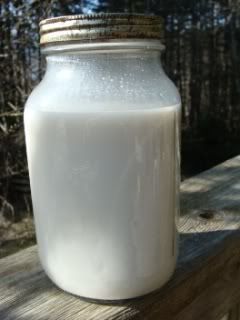
In my post about making raw hemp milk, I mentioned using the soymilk maker to make a hemp milk that wouldn't separate so easily. I tried several batches before I got it to my satisfaction-- the results are below-- and it, indeed, does not separate as easily as the raw version. But it does eventually separate after standing in the refrigerator for a day or so. However, you can shake it up and it's just fine.
I had a little accident with one batch that I made, but, never one to waste food, I salvaged something good out of it! You can see that tale below the milk recipe!
Printable Recipe
BRYANNA'S SOYQUICK HEMP AND OAT MILK
Yield: 5 1/2 cups
This is a nice mild nondairy milk. You need the filterless SoyQuick Premier
5 1/2 cups water (up to the "minimum" mark in the SoyQuick container)
3/4 cup shelled hemp seeds
3 tablespoons rolled oats
1 1/2 to 2 tablespoons organic sugar
IMPORTANT: IF YOU USE AGAVE NECTAR, DO NOT ADD UNTIL THE MILK COOLS OR IT WILL CURDLE! (see what happens below!)
1/2 teaspoon salt
Add water , hemp seeds, and oats to the Soy Quick container. Attach the rest of the machine, plug in and press the "Multigrain" setting.
When it beeps, remove the grinding mechanism, etc:
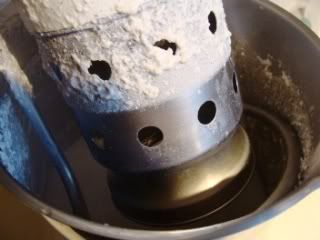
You'll see a residue or hemp seed and oats on the blade protector, etc.
and pour the milk through a cloth inside of a colander placed over a pot (sterilize all equipment with boiling water).
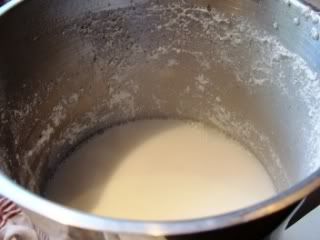
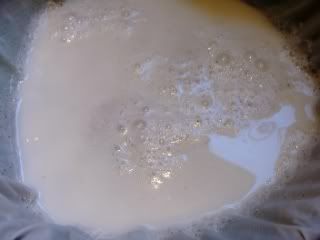
Let it drain and then pull up the sides of the cloth, twist and squeeze until all the milk is in the pot and you are left with a small residue on the inside of the cloth (discard that).
Stir in the sugar and salt, pour the milk into a scalded glass jug or canning jars, cap tightly, and refrigerate.
IF YOU USE AGAVE NECTAR FOR THE SWEETENER, DO NOT ADD IT TO THE HOT MILK, OR THE ACID IN THE AGAVE WILL CURDLE THE MILK! WAIT UNTIL THE MILK COOLS OFF. (See what happens below!)
The hemp milk will probably separate after a day or so-- just shake it up before serving.
Nutrition Facts
Nutrition (per 1/2 cup): 70.1 calories; 46% calories from fat; 3.7g total fat; 0.0mg cholesterol; 91.5mg sodium; 4.9mg potassium; 5.2g carbohydrates; 0.5g fiber; 2.1g sugar; 4.7g net carbs; 4.2g protein; 1.6 points.
OKAY, SO WHAT ABOUT THAT "ACCIDENT"?
With one of my test batches, I unthinkingly added agave nectar to the fresh, hot hemp milk and poured it into jars. This is what happened:
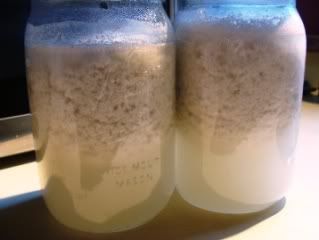
I instantly knew that that "citrusy" flavor I detect in agave nectar is acidity! Not one to waste food, I gently poured the contents of both jars (a little at a time) into the cloth lined tofu press that comes with the SoyQuick. However, the curds were very fragile, so I didn't want to press them. I gathered up the cloth after it had drained for a time in the sink, tied it with a rubber band and drained it on the end of the sink tap:
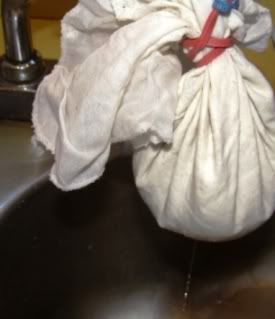
After it drained for several hours, I scraped it out of the cloth into a small bowl and was left with about 1/2 a cup of "hemp curd cheese":
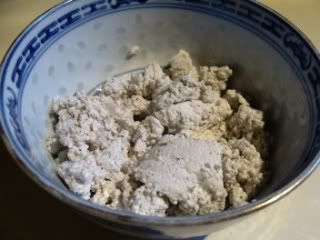
I seasoned the curds with a little salt, garlic, and herbs and used it as a tasty spread:
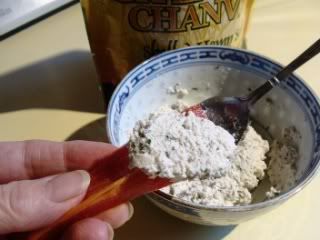
This would probably not be worth doing on purpose very often, as the yield is meager and it would be fairly expensive. But it was certainly good!
Enjoy!

Labels:
hemp and oat milk,
hemp curds,
hemp milk,
homemade hemp milk
Thursday, March 12, 2009
VEGAN PEANUT BUTTER SWIRL BROWNIES! (SF AND CAN BE GF)

I love just about anything with peanut butter and chocolate together, and these brownies (actually pretty low in fat) are no exception. They are dark and rich-tasting. (If you are allergic to peanuts, substitute another tasty nut butter-- I would suggest roasted hazelnut butter.) These are easy to make!
Printable Recipe
BRYANNA’S VEGAN PEANUT BUTTER SWIRL FUDGE BROWNIES
(Soy-Free and can be GF)
Makes 16 squares
BROWNIE BATTER:
3 TBS. oil
3 TBS. boiling water
1 c. packed brown sugar
1/2 c. organic Dutch process cocoa powder
2 tsp. pure vanilla extract
1 TBS. grated orange zest (organic, if possible— orange part only)
1/4 c. water
1 TBS. whole flax seeds OR 1 1/2 TBS. ground flax seed (flax meal)
1TBS. Ener-G egg replacer
1/2 c. regular whole wheat flour or unbleached flour (NOT pastry flour) OR a GF flour mix
1/2 tsp. baking powder
1/4 tsp. salt
PEANUT BUTTER SWIRL:
Mix together in a bowl:
1/2 c. natural peanut butter (or you could use other nut butters, such as hazelnut)-- use a brand that is fairly runny, not dry
1/3 c. packed brown sugar
2 tsp. Ener-G Egg Replace
2 TBS. water
1 TBS. flour
1/4 tsp. pure vanilla extract
Preheat the oven to 350 degrees F.
In a small bowl mix together the oil and boiling water, then whisk in the sugar until dissolved. Whisk in the cocoa, vanilla and orange zest until well combined. Set aside.
Place the 1/4 c. water, flax seeds (or ground flax) and egg replacer in a blender or mix with a stick/immersion blender
In a small bowl, mix together the flour, baking powder, salt and nuts. Add the flour mixture to the cocoa mixture and stir briefly.
Spread brownie batter in an 8” square baking pan, greased lightly with margarine or sprayed with pan spray or oil from a pump sprayer
Mix up the Peanut Butter Swirl mixture. Drop the mixture in 9 small “blobs” evenly spaced over the brownie batter.
Swirl the peanut butter mixture through the batter with a knife, as if making a marble cake.
Bake for 25 minutes.
Cool on a rack (yes, you have to wait!), then cut into 16 squares.
Nutrition Facts
Nutrition (per square): 165.6 calories; 34% calories from fat; 6.8g total fat; 0.0mg cholesterol; 61.7mg sodium; 202.5mg potassium; 25.7g carbohydrates; 2.3g fiber; 18.4g sugar; 23.4g net carbs; 3.2g protein; 3.4 points.
Enjoy!
Labels:
brownies,
chocolate,
peanut butter,
vegan brownies
Monday, March 9, 2009
EAGLES, ORCAS, VEGAN ANCHOVY SUB, AND OUR FAVORITE FAST MEAL!




Above is a series of 3 photos that my husband, Brian Grogan, took last Wednesday when we went for a walk on the south end of our home island, Denman Island, BC, at Boyle Point and Eagle Rock. The herring run is happening now and lots of wildlife about. We could just make out the sea lions congregating on a little uninhabited island off of Hornby Island, the next island over. We could hear them barking, and then a deep, rumbling sound that got louder as we got closer-- it was the bulls roaring! These eagles were on a tree just down from where we were standing.
Here was our view of the water, mountains and Chrome island, the old lighthouse Island, below us:

Something really exciting happened on our way to go shopping on Saturday-- when we were on the ferry there was a pod of Orcas making it's way up Baynes Sound (which separates us from Vancouver Island), no doubt eating herring along the way, and cavorting in the water. I have never seen Orcas firsthand, so it was pretty exciting! Twice, a big one jumped vertically out of the water, showing his or her white belly. We could see a huge dorsal fin sticking up out of the water in the distance-- must have been the Grampa of the group! Unfortunately, we didn't have cameras! It was a fun ride-- the captain went really slowly and everyone on the boat was out of their cars crowding to the railings to watch. Everyone was excited and grinning and it felt very good!
In this ocean-y context, I want to talk a bit about what I substitute for anchovies in my Italian cooking because this pertains to the recipe below. Anchovies are frequently used as a flavor booster-- lots of umami (see here and here)-- in Italian cooking, especially so-called "meatless" cooking. When I was writing my Italian vegan cookbook, Nonna's Italian Kitchen, I noticed that miso has a complex, salty, fermented flavor very much like preserved anchovies. Just like anchovies do, miso provides that mysterious "something" to many dishes, that secret ingredient (umami) that makes a dish taste so delicious, but you can't figure out what it is. I discovered that I can use miso in place of anchovies, at the rate of 3/4-1 tsp. for each fillet, or use an equal amount of miso if anchovy paste is called for. (Of course, this won't work in sauces which consist primarily of anchovies.)
Below is a good example of this usage, a recipe that I pull out when I want a tasty, satisfying meal but have only 10 or 15 minutes to throw it together! I usually have everything already, so all I need is a salad. It's a pasta with a naughty name and a possibly dodgy history, but, oh, it's good!
Printable Recipe
BRYANNA’S VEGAN SPAGHETTI ALLA PUTTANESCA
Servings: 6
This dish with the unrefined name "Spaghetti in the manner of a prostitute" is exceedingly popular-- and so-named perhaps because the “ladies of the night” made it quickly when they had a chance. Anchovies are replaced by miso in this vegan version.
NOTE: This pasta dish is traditionally not eaten with cheese, so don’t worry about a substitute.
1 lb. spaghetti (a good brand)
1-3 T. extra-virgin olive oil
2 cloves garlic, sliced
1" piece of dried hot red pepper (or 1/4 tsp. chili flakes)
2 lbs. ripe plum tomatoes, chopped (don’t peel and seed them—that’s where most of the flavor is)
OR a 28 oz. can of good Italian tomatoes, drained (save juice)
2/3 cup pitted and sliced black calamata olives
1 T. capers (optional)
2 T. soy or chickpea miso (not the very dark variety)
2 T. chopped fresh Italian parsley
freshly-ground black pepper to taste
Put on a large pot of salted water to boil for the pasta. Pour the drained tomatoes (if using canned) into a bowl and “squish” them up, or break them up, with your fingers.
In a large heavy skillet or pot, heat the olive oil over medium heat. Add the garlic and hot pepper and cook just until the garlic starts to change color slightly. Add the tomatoes, olives and capers and let simmer while you cook the spaghetti to the al dente stage. (If you are using canned tomatoes and the sauce is too dry, add some of the reserved tomato juice.)
Mash the miso in a small bowl with some of the sauce, then add it back to the sauce and stir well. Taste for salt and pepper. Add the drained pasta, toss well and cook for a minute. Sprinkle with parsley and serve immediately.
Nutrition Facts (calculated using only 1 tablespoon oil)
Nutrition (per serving): 415.4 calories; 23% calories from fat; 11.1g total fat; 0.0mg cholesterol; 711.7mg sodium; 480.2mg potassium; 68.4g carbohydrates; 4.1g fiber; 6.6g sugar; 64.3g net carbs; 11.7g protein; 8.4 points.
Enjoy!

Labels:
miso,
olives,
pasta,
tomatoes,
Vegan Pasta alla Puttanesca
Subscribe to:
Comments (Atom)












